IEEE TRANSACTIONS ON INFORMATION THEORY, VOL. 68, NO. 8, AUGUST 2022 4901
Quadratically Constrained Myopic Adversarial Channels
Yihan Zhang , Shashank Vatedka ,Member, IEEE, Sidharth Jaggi, Senior Member, IEEE, and Anand D. Sarwate , Senior Member, IEEE
Abstract— We study communication in the presence of a jam- ming adversary where quadratic power constraints are imposed on the transmitter and the jammer. The jamming signal is allowed to be a function of the codebook, and a noncausal but noisy observation of the transmitted codeword. For a certain range of the noise-to-signal ratios (NSRs) of the transmitter and the jammer, we are able to characterize the capacity of this channel under deterministic encoding or stochastic encoding, i.e., with no common randomness between the encoder/decoder pair. For the remaining NSR regimes, we determine the capacity under the assumption of a small amount of common randomness (at most2 log(n)bits in one sub-regime, and at mostΩ(n)bits in the other sub-regime) available to the encoder-decoder pair. Our proof techniques involve a novel myopic list-decoding result for achievability, and a Plotkin-type push attack for the converse in a subregion of the NSRs, both of which may be of independent interest. We also give bounds on the strong secrecy capacity of this channel assuming that the jammer is simultaneously eavesdropping.
Index Terms— Channel coding, communication channels, chan- nel capacity, channel state information, Gaussian channels, Manuscript received 5 January 2020; revised 4 May 2021; accepted 24 October 2021. Date of publication 14 April 2022; date of current version 13 July 2022. This work was supported in part by the University Grants Com- mittee of the Hong Kong Special Administrative Region under Project AoE/E- 02/08 and in part by the General Research Fund (GRF), Research Grants Council (RGC) under Grant 14208315 and Grant 14313116. The work of Yihan Zhang was supported by the European Union’s Horizon 2020 Research and Innovation Programme under Grant 682203-ERC-[Inf-Speed-Tradeoff].
The work of Shashank Vatedka was supported in part by the Chinese Univer- sity of Hong Kong (CUHK) Direct under Grant 4055039 and Grant 4055077.
The work of Anand D. Sarwate was supported in part by the U.S. National Science Foundation under Award CCF-1909468. An earlier version of this paper was presented in part at the 2012 International Conference on Sig- nal Processing and Communications [1] [DOI: 10.1109/ISIT.2018.8437457]
and in part at the 2018 IEEE International Symposium on Information theory [2] [DOI: 10.1109/SPCOM.2012.6290241]. (Corresponding author:
Yihan Zhang.)
Yihan Zhang was with the Department of Information Engineering, The Chinese University of Hong Kong, Hong Kong, and also with the Henry and Marilyn Taub Faculty of Computer Science, Technion—Israel Institute of Technology, Haifa 3200003, Israel. He is now with the Institute of Science and Technology Austria, 3400 Klosterneuburg, Austria (e-mail:
Shashank Vatedka was with the Institute of Network Coding, The Chinese University of Hong Kong, Hong Kong, and also with the Department of Communications and Electronics, Télécom Paris (Institut Polytechnique de Paris), 91120 Palaiseau, France. He is now with the Department of Electrical Engineering, Indian Institute of Technology Hyderabad, Hyderabad 502285, India (e-mail: [email protected]).
Sidharth Jaggi is with the School of Mathematics, University of Bristol, Bristol BS8 1TH, U.K. (e-mail: [email protected]).
Anand D. Sarwate is with the Department of Electrical and Computer Engineering, Rutgers, The State University of New Jersey, New Brunswick, NJ 08854 USA (e-mail: [email protected]).
Communicated by R. Safavi-Naini, Associate Editor for Cryptography.
Color versions of one or more figures in this article are available at https://doi.org/10.1109/TIT.2022.3167554.
Digital Object Identifier 10.1109/TIT.2022.3167554
multiuser channels, time-varying channels, communication system security.
I. INTRODUCTION ANDPRIORWORK
C
ONSIDER a point-to-point communication system where a transmitter, Alice, wants to send a message to a receiver, Bob, through a channel distorted by additive noise.She does so by encoding the message to a length-ncodeword, which is fed into the channel. Much of traditional commu- nication and information theory has focused on the scenario where the noise is independent of the transmitted signal and the coding scheme. We study the case where communication takes place in the presence of a malicious jammer (whom we call James) who tries to ensure that Bob is unable to recover the transmitted message. The channel is a discrete-time, real- alphabet channel, and the codeword transmitted by Alice is required to satisfy a quadratic power constraint. It is assumed that the coding scheme is known to all three parties, and James also observes a noisy version of the transmitted signal (hence the termmyopic). The jamming signal is required to satisfy a separate power constraint, but otherwise can be a noncausal function of the noisy observation and the coding scheme.
This problem is part of the general framework of arbitrarily varying channels (AVCs), introduced by Blackwell et al. [3].
The quadratically constrained AVC (also called the Gaussian AVC) was studied by Blachman [4], who gave upper and lower bounds on the capacity of the channel under the assumption that James observes a noiseless version of the transmitted codeword (a.k.a. theomniscient adversary). The lower bound used a sphere packing argument similar to the one used to prove the Gilbert-Varshamov (GV) bound for binary linear codes. The upper bound was based on Rankin’s upper bound on the number of non-intersecting spherical caps that can be placed on a sphere [5]. The quadratically constrained AVC is closely related to the sphere-packing problem where the objective is to find the densest arrangement of identical n-dimensional balls of radius√
nN subject to the constraint that the center of each ball lies within a ball of radius√
nP. An exact characterization of the capacity of this problem is not known, though inner [4] and outer bounds [6], [7]
are known. At the other end of the spectrum, Hughes and Narayan [8], and later Csiszár and Narayan [9], studied the problem with an “oblivious” James, who knows the codebook, but does not see the transmitted codeword. They consider the regime when P > N (it can be shown that no positive throughput is possible whenP < N). They showed that under an average probability of error metric, the capacity of the
0018-9448 © 2022 IEEE. Personal use is permitted, but republication/redistribution requires IEEE permission.
See https://www.ieee.org/publications/rights/index.html for more information.
oblivious adversarial channel is equal to that of an additive white Gaussian noise (AWGN) channel whose noise variance is equal to the power constraint imposed on James. These omniscient and oblivious cases are two extreme instances of the general myopic adversary that we study in this paper.
The oblivious vector Gaussian AVC was studied by Hughes and Narayan [10], and later Thomas and Hughes [11] derived bounds on the error exponents for the oblivious Gaussian AVC.
Sarwate and Gastpar [12] showed that the randomized coding capacity of the oblivious channel is the same under average and maximum error probability constraints.
This work builds on [1], which characterized the capacity of this channel under the assumption that James knows a noisy version of the transmitted signal, but Alice’s codebook is shared only with Bob. This can be interpreted as a myopic channel with an unlimited amount of common randomness (or shared secret key, CR) between Alice and Bob. A related model was studied by Haddadpour et al. [13], who assumed that James knows the message, but not the exact codeword transmitted by Alice. In this setup, Alice has access to private randomness which is crucially used to pick a codeword for a given message. However, Alice and Bob do not share any common randomness. Game-theoretic versions of the problems have also been considered in the literature, notably by Médard [14], Shafiee and Ulukus [15] and Baker and Chao [16]. Shafiee and Ulukus [15] considered a more general two-sender scenario, while Baker and Chao [16] studied a multiple antenna version of the problem. More recently, Hosseinigoki and Kosut [17] derived the list-decoding capacity of the Gaussian AVC with an oblivious adversary. Zhang and Vatedka [18] derived bounds on achievable list-sizes for random spherical and lattice codes. Pereg and Steinberg [19]
have analyzed a relay channel where the observation of the destination is corrupted by a power-constrained oblivious adversary. Beemer et al. [20] studied a related problem of authentication against a myopic adversary, where the goal of the decoder is to correctly either decode the message or detect adversarial interference. Zhang et al. [21] also studied a quadratically constrained two-way interference channel with a jamming adversary, where proof techniques similar to ours were used to obtain upper and lower bounds on the capac- ity. Budkuley et al. [22] gave an improved symmetrization (known as CP-symmetrization where CP is for completely positive) bound for myopic AVCs over discrete alphabets.
The result expands the parameter region where the capacity (without common randomness) is zero. The proof is based on a significant generalization of the Plotkin bound in classical cod- ing theory which is proved by Wang et al. [23]. Dey et al. [24]
studied, among others, the binary erasure-erasure myopic adversarial channels and gave nontrivial achievability schemes beating the Gilbert–Varshamov bound in the insufficiently myopic regime.
Communication in the presence of a myopic jammer has also received considerable attention in the discrete-alphabet case (see [25] and references therein, and the recent [26], [27]
on covert communication with myopic jammers). We would like to draw connections to the bit-flip adversarial problem where communication takes place over a binary channel, and
James observes the codeword through a binary symmetric channel (BSC) with crossover probability q. He is allowed to flip at mostnpbits, where0< p <1/2can be interpreted as his “jamming power.” Dey et al. [25] showed that when James is sufficiently myopic, i.e.,q > p, the capacity is equal to1−H(p). In other words, he can do no more damage than an oblivious adversary. As we will see in the present article, this is not true for the quadratically constrained case. We will show that as long as theomniscient list-decoding capacityfor Bob is greater than theAWGN channel capacityfor James, the capacity is equal to a certain myopic list-decoding capacity for Bob. In this regime, James cannot uniquely determine the transmitted codeword among exponentially many. As a result no attack strategy by James that “pushes” the transmitted codeword to the nearest other codeword is as bad as in the omniscient case since the nearest codeword in general will be different for different choices of the transmitted codeword.
Recent works have also considered communication with simultaneous active and passive attacks [28]–[34]. However, in these works, the eavesdropper and jammer are assumed to be independent entities and the jammer is assumed to be an oblivious adversary. In this work, we derive lower bounds on the capacity of the myopic adversarial channel with an additional wiretap secrecy [35] constraint, treating the jammer as an eavesdropper at the same time.
Let us now describe the problem we address in this paper.
The setup is illustrated in Fig. 1. Alice wants to send a message m to Bob. The message is assumed to be uniformly chosen from {0,1}nR, where R >0 is a parameter called the rate.
Alice and Bob additionally havenkeybits of shared secret key, k(nkeycould be zero — indeed, some of the major results in this work derive AVC capacity for some NSR regimes when nkey= 0). This key is kept private from James. Alice encodes the message m (using k) to a codeword x ∈ Rn, which is transmitted across the channel. Let C denote the set of all possible codewords (the codebook). In this work, we study three types of encoding:
• Deterministic encoding:nkey= 0andxis a deterministic function of m
• Stochastic encoding:nkey= 0, butxis a function ofm and private random bits known only to Alice
• Randomized encoding:nkey>0, andxcan be a function of the shared keykand random bits known only to Alice.
If the code is non-deterministic, then the codebook rate Rcode := n1log|C| could be different from themessage rate R (which we sometimes simply refer to as the rate). The codebook must satisfy a power constraint of P > 0, i.e.
x2≤√
nP for allx∈ C. James seesz=x+sz, wheresz
is an AWGN with mean zero and variance σ2. He chooses a jamming vector s ∈ Rn as a noncausal function of z, the codebook C, and his private randomness. The jamming vector is also subject to a power constraint: s2 ≤ √
nN for some N > 0. Bob obtains y = x+s, and decodes this to a messagem. The message is said to have been conveyed reliably if m = m. The probability of error, Pe, is defined as the probability that m = m, where the randomness is over the messagem, the private randomness that Alice uses,
ZHANGet al.: QUADRATICALLY CONSTRAINED MYOPIC ADVERSARIAL CHANNELS 4903
Fig. 1. The setup studied in this paper: Alice wants to transmitnR-bit messagemto Bob. Across the channel, she transmits a codewordx, which is a function ofm(and potentially a shared keykofnkeybits, though we also study the scenario whennkey= 0). The collection of codewordsCis called the codebook, and every codeword in the codebook must satisfy a power constraint of√
nP. The jammer James observeszcorresponding to the output of an AWGN channe with varianceσ2. He then chooses a jamming/state sequences(satisfying a power constraint of√
nN) as a noncausal function ofszandC. On observingy=x+s, Bob must output his estimatemˆ of the messagemsuch that the probability of error (averaged overmandsz) vanishes.
the random noise sz, the key k, and the private random bits available to James.1 In all our code constructions,2 we will assume that Alice and Bob may share a secret key, but the mapping from (m,k) to x is deterministic. In other words, Alice does not possess any source of additional private randomness. Conversely, all our impossibility results are robust to the presence of private randomness at the encoder (since in some AVC scenarios, private randomness is known to boost capacity — e.g. [36]) We study the problem with different amounts of common randomness shared by Alice and Bob but unknown to James, and present results in each case.
We say that a rate R > 0 is achievable if there exists a sequence (in increasing n) of codebooks for which the probability of error3 goes to zero as n→ ∞. The supremum of all achievable rates is called the capacity of the channel.
We say that a rate R > 0 is achievable with (wiretap) secrecy if there exists a sequence (in increasing n) of code- books for which the probability of error and the mutual information I(m;z) both go to zero as n → ∞. This is commonly referred to as the strong secrecy requirement in
1An averaging argument shows that the rate cannot be improved even if Bob uses additional private random bits for randomized decoding.
2An exception is Appendix C, where we show that private randomness does not increase the capacity of the omniscient adversarial channel. However, we have reason to believe (albeit unsupported by formal proof) that additional private randomness mayincrease the achievable rate — this is part of our ongoing investigation.
3See Sec. V for a formal definition.
the literature. The supremum of all achievable rates is called the secrecy capacity of the channel.
A. Organization of the Paper
We give a summary of our results and proof techniques in Sec. II. The formal statements of the results are presented in Sec. VI. The main results are also compactly summarized in Table I and the results with secrecy are tabulated in Table II.
We then discuss the connection between our work and several closely related prior works in Sec. III. Notation and prelimi- naries are described in Sec. IV and Sec. V, respectively. This, as mentioned, is followed by ideas and details of the proof techniques in Sec. VI. In Sec. VII, we describe the results for infinite common randomness and give a formal proof of the converse. Sec. VIII contains the main ideas required to prove our results with linear and logarithmic amounts of common randomness. Our results on list-decoding are described in Sec. VIII-A, with Theorem 14 giving the main result. Coming to the no-common randomness regime, we present a technical yet high-level proof sketch of the achievability and a full proof of the symmetrization converse in Sec. IX. Sec. X contains a detailed proof of Theorem 11, and Sec. XI gives the proof of Theorem 14. Appendix C has a note on why private randomness does not improve the capacity if James is omniscient. We transcribe a rigorous proof of a folklore theorem regarding list-decoding in Euclidean space against an omniscient adversary in Sec. D. Some of the technical
details of proofs appear in the other appendices (specifically Appendix B and Appendices E–H). Frequently used notation is summarized in Table III in Appendix A. Fig. 21 is a flowchart outlining steps involved in the proof.
II. OVERVIEW OFRESULTS ANDPROOFTECHNIQUES
A. Overview of Results
We now briefly describe our results and proof techniques.
It is helpful to visualize our results in terms of the noise- to-signal ratio (NSR), using a N/P (adversarial NSR to Bob) versus σ2/P (random NSR to James) plot similar to the one shown in Fig. 8.4 In [1], it was shown that with an infinite amount of common randomness, the capacity is RLD := 12logNP in the red region, and RLD,myop :=
1 2log
(P+σ2)(P+N)−2P√
N(P+σ2) Nσ2
in the blue region. The capacity is zero in the grey region.
In this article, while the major results are for the case when nkey = 0, along the way we prove anciliary results for the regimes where nkey= Θ(n)andnkey= Θ(logn).
• List-Decoding: We prove a general result for list-decoding in the presence of a myopic adversary. For an omniscient adversary, the list-decoding capacity is RLD = 12logPN. This is a folklore result, but we give a proof of this statement in Appendix D for completeness.
When the adversary is myopic, and the encoder-decoder pair sharesO(n) bits of common randomness, we give achievable rates for list-decoding. This is equal to RLD for σP2 ≤ NP −1, and is larger than RLD in a certain regime (depending on the amount of common randomness) where σP2 > NP −1. The achievable rates are illustrated in Fig. 7. With no common randomness, we can achieveRLD andRLD,myop in the red and blue regions of Fig. 7a respectively. If Alice and Bob share nkeybits, thenRLD,myopis achievable in a larger region.
For instance, if nkey = 0.2n, then the blue region can be expanded to give Fig. 7b.
• Linear CR: When common randomness is present, we combine our list-decoding result with [37, Lemma 13] to give achievable rates over the myopic adversarial channel. Let us first discuss the case the amount of common randomness is linear inn, i.e.,nkey=nRkeyfor someRkey >0. IfRkey≥ 12log
1 +σP2
−RLD,myop, then we are able to give a complete characterization of the capacity of the channel for all values of the NSRs. We can achieve everything in Fig. 8. IfRkey< 12log
1 +σP2
− RLD,myop, then we are able to characterize the capacity in only a sub-region of the NSRs — This is illustrated in Fig. 6c and Fig. 6d for different values ofRkey. In the dotted regions, we only have nonmatching upper and lower bounds. It is worth pointing out that no fixedRkey
will let us achieve RLD,myop in the entire blue region of Fig. 8. However, for every point in the blue region,
4Our parameterization makes the parameter regions of interestcompactand concentrated in a bounded region around the origin (rather than scattered or shooting infinitely far away) in the two-dimensional plane spanned byσ2/P andN/P.
there exists a finite value ofRkeysuch thatRLD,myop is achievable at that point. In other words, annkey= Ω(n) is sufficient to achieve RLD,myop at every point in the interior of the blue region in Fig. 8.
• Logarithmic CR: For thenkey = Θ(logn) case, we are able to find the capacity in the red and blue regions in Fig. 6b. In the dotted regions, we have nonmatching upper and lower bounds.
• No CR: For nkey = 0, we require a more involved approach to find the capacity. We use some of the results on myopic list-decoding in our bounds for the probability of error. We find the capacity in the red, blue and grey regions in Fig. 6a, but only have nonmatching upper and lower bounds in the dotted green and white regions.
• Sufficiency of Deterministic Encoding Against Omniscient Adversaries: We show that if James is omniscient, then private randomness at the encoder does not help improve the capacity. This is based on a similar observation made by Dey et al. [36] for the bit-flip adversarial channel. See Appendix C for details.
• Wiretap Secrecy: We use the above results to derive achievable rates under strong secrecy constraints. Specif- ically, we want to ensure that the mutual information to James, I(m;z) =o(1) in addition to Bob being able to decodem reliably. Since the proof of reliability uses a random spherical code construction, we are able to obtain strong secrecy using random binning by ensuring that the code corresponding to each bin is a good resolvability code [38] for the AWGN channel from Alice to James.
The variation of the regions of the noise-to-signal ratios (NSR) where we can obtain achievable rates is illustrated in Fig. 9.
As seen in the figure, even Θ(logn) bits of common ran- domness is sufficient to ensure that the red and blue regions are expanded. An additionalΘ(n)bits can be used to expand the blue region even further, eventually achieving everything in Fig. 8. The rates derived in this paper are compared with prior work in Table I.5
B. Proof Techniques for Converse Results
We begin by outlining the proof techniques used in our converse results. At first sight, it might seem that geomet- ric/sphere packing bounds such as in [6] may be used when Bob’s NSR N/P is higher than James’s NSR σ2/P, since whenever Bob can hope to decode Alice’s message, so can James. If Alice’s encoder is deterministic, James can therefore infer Alice’s transmitted codeword, and thereby “push” it to the nearest codeword. However, such a reasoning applies only to deterministic codes, i.e., when Alice does not use any private or common randomness. We therefore highlight two converse techniques that apply even when Alice’s encoder is not deterministic.
5Many prior works (for example [1], [14] etc.) also consider additional random noise, independent of the jamming noise introduced by James, on the channel from Alice to Bob. In principle the techniques in this paper carry over directly even to that setting, but for ease of exposition we choose not to present those results.
ZHANGet al.: QUADRATICALLY CONSTRAINED MYOPIC ADVERSARIAL CHANNELS 4905
1) Scale-and-Babble:The scale-and-babble attack is a strat- egy that reduces the channel from Alice to Bob into an AWGN channel. James expends a certain amount of power in cancelling the transmitted signal, and the rest in adding independent Gaussian noise. Since the capacity of the AWGN channel cannot be increased using common randomness, the scale-and-babble attack gives an upper bound that is valid for all values of nkey. This technique gives us the rate region illustrated in Fig. 10. The capacity is upper bounded by RLD
in the red region,RLD,myop in the blue region, and is zero in the grey region.
We remark that the scale-and-babble attack is not an original idea of this work. This proof was suggested by Sarwate [1], and is an application of a more general technique proposed by Csiszár and Narayan [39] to convert an AVC into a discrete memoryless channel. Nevertheless we give a complete proof to keep the paper self-contained.
2) Symmetrization Attacks: Symmetrization attacks give us upper bounds on the throughput when Alice and Bob do not share a secret key, but hold regardless of whether Alice’s encoder uses private randomness or not. We give two attacks for James:
• A z-aware symmetrization attack: James picks a code- wordxfrom Alice’s codebook uniformly at random and independently of z. He transmits (x −z)/2 — since z=x+szfor some vectorszwithN(0, σ2)components, therefore Bob receives (x+x −sz)/2. If x = x, then Bob makes a decoding error with nonvanishing probability. This attack is inspired by a technique used to prove the Plotkin bound for bit-flip channels. The symmetrization attack lets us prove that the capacity is zero when σP2 ≤ 1−N/P1 −2 (Fig. 11c). The z-aware attack is novel in the context of myopic channels, but is also inspired by similar ideas in [40].
• Az-agnostic symmetrization argument:This lets us show that the capacity is zero for N > P (Fig. 11b). James picks a codeword x as before but instead transmits s=x. Bob receives x+x and we can show that the probability of error is nonvanishing. Thez-agnostic sym- metrization attack was used by Csiszár and Narayan [9]
to show that the capacity of the oblivious adversarial channel is zero forN > P.
The scale-and-babble attack holds for all values of nkey
since it involves reducing the channel into an equivalent AWGN channel, and the capacity of the AWGN channel cannot be increased using common randomness. On the other hand, the symmetrization arguments are not valid when nkey>0. Indeed, we will show that strictly positive rates can be achieved in the symmetrizable regions with evenΩ(logn) bits of common randomness.
Combining the three techniques give us the upper bounds in Fig. 12.
C. Proof Techniques for Achievability Results
The achievability proofs for the three regimes of nkey
outlined above involve some common techniques. We now give a high-level description of some of the ideas. Fundamental
to the achievability proofs is the concept of list-decoding.
In all the achievability proofs, we use random spherical codes C = {x(m, k) : 1 ≤ m ≤ 2nR,1 ≤ k ≤ 2nkey}, where each x(m, k) is sampled independently and uniformly from the sphereSn−1(0,√
nP)inRn centred at0 and comprising of vectors of magnitude√
nP.
1) Myopic List-Decoding: This is a central idea in our proofs, and a novel contribution of this work. The broad idea is to use myopia to ensure that James is unable to uniquely recover the transmitted codeword. We show that if the codebook rate is sufficiently large, then there are exponentially many codewords that from James’s perspective Alice could plausibly have transmitted. Due to this confusion, no attack strategy (by pushing the transmitted xin the direction of the nearest other codeword x, since the nearest codeword will in general be different directions for different x) by James is as bad as the one he could instantiate in the omniscient case. We study the list-decoding problem, where instead of recovering the transmitted message uniquely, Bob tries to out- put a poly(n)sized list that includes the transmitted codeword.
Since James is myopic, we could hope to achieve rates greater than the omniscient list-decoding capacity RLD. Even with nkey = 0, we can achieve a higher rate, equal to RLD,myop, in the blue region in Fig. 7a. The blue region can be expanded with a larger amount of common randomness, as seen in Fig. 7b. We will in fact show that the list-decoding capacity is equal toCmyop,rand(see Eqn. (VI.1) for its definition) ifnkey
is large enough.
Let us briefly outline the proof techniques. We show that conditioned on z, the transmitted codeword lies in a strip (informally denoted by Str for now) approximately at a distance √
nσ2 to z. See Fig. 2 for an illustration. If the codebook rate exceeds 12log
1 + σP2
, then this strip will contain exponentially many codewords. All these codewords are roughly at the same distance to z and are therefore nearly indistinguishable from the one actually transmitted.
We operate under the assumption of a more powerful adversary who has, in addition toz, access to an oracle. This is a matter of convenience and will greatly simplify our proofs. The oracle reveals an exponential sized subset of the codewords (that includesx) from the strip. We call this the oracle-given set (OGS). We prove that for most codewords in the OGS, no attack vectorscan eventually force a list-size greater than poly(n)as long as the rate is less thanCmyop,rand. To prove this result, we obtain a bound on thetypicalarea of the decod- ing regionSn−1(0,√
nP)∩ Bn(x+s,√
nN). We will show that for certain regimes of the noise-to-signal ratios (NSRs), the volume of the decoding region is typically much less than the worst-case scenario (i.e., had James knownx). This gives us an improvement over the omniscient list-decoding capacity.
2) Reverse List-Decoding: This technique, along with myopic list-decoding outlined above, is used to obtain achiev- able rates in the case where Alice and Bob do not share any common randomness. Given an attack vectors, we say thatx confusesxifx lies withinBn(x+s,√
nN). In list-decoding, we attempt to find the number of codewords that could potentially confuse the transmitted codeword. Our goal in the list-decoding problem is to keep the number of confusable
Fig. 2. Illustration of the strip and the oracle-given set (OGS). All codewords in the strip (the collection of red, blue and green points) are roughly at the same distance fromz, and hence approximately have the same likelihood of being transmitted. The OGS (illustrated as red and green points) is a randomly chosen subset of the codewords in this strip.
codewords to a minimum. In reverse list-decoding, we ask the opposite question: Given a potentially confusing codeword, how many codewords in the strip could this confuse?
For every codewordx and attack vectors, we could define the reverse list-size as |{x∈ Str:x+s−x2≤√
nN}|. In other words, this is the number of codewords in the strip which when translated bys, are confusable withx. Our goal is to keep this as small as possible (in fact, poly(n)) for all possible attack vectorss. We show that small reverse list-sizes are guaranteed as long as 12logNP >12log
1 + σP2
, i.e. in the red and blue regions of Fig. 13.
3) Going From List-Decoding to Unique Decoding:Obtain- ing results for unique decoding uses two different approaches that depends on the amount of common randomness.
• Linear/logarithmic amount of common randomness:
Langberg [41] gave a combinatorial technique to convert any list-decodable code (with no common randomness) for a binary channel into a uniquely decodable code of the same rate withΩ(logn)bits of common randomness.
This was later generalized by Sarwate [37] to arbitrary AVCs, and [42] recently showed that only(1 +ε) logn bits suffices (whereεdenotes the difference between the list-decoding capacity and the transmission rate). This combined with our result on myopic list-decoding will give us an achievable rate for reliable communication over the myopic channel.
• No common randomness: The ideas in myopic list-decoding can be used to show that there are at most poly(n) codewords that can potentially confuse the exponentially many codewords in the OGS. Using reverse list-decoding, we can conclude that each codeword outside the OGS can confuse at most poly(n) codewords in the OGS. Using this, and a “grid argument”
along the lines of [25], we can show that the probability of decoding error is vanishingly small.
4) Two Uses of the Common Randomness:When Alice and Bob have onlyO(logn)bits of common randomness,kis only used to find the true message from the list using the approach proposed in [37], [41]. However, when Alice and Bob have Ω(n) bits of shared secret key, there are two different uses fork.
Recall from our discussion above that to obtain an improve- ment over omniscient list-decoding, we must ensure that James is sufficiently confused about the true codeword. If he can recoverxwith high probability (w.h.p.), then there would be no hope of achieving rates greater than RLD. When Alice and Bob share linear amounts of common randomness, all but(1 +ε) lognbits is used to ensure that the strip contains exponentially many codewords. This is done by generating 2nkey−(1+ε) lognindependent codebooks, each containing2nR codewords. Based on the realization of the key, Alice picks the appropriate codebook for encoding. Since Bob knows the key, he can use this codebook for decoding. However, James does not have access to the shared secret key and to him, all the 2nR+nkey−(1+ε) logn codewords are equally likely to have been transmitted. This ensures that James is sufficiently confused about the true codeword. The remaining(1+ε) logn bits are then used to disambiguate the list at the decoder.
III. COMPARISONWITHOTHERWORKS
We now describe the similarities and differences with three closely related works.
Sarwate [1] derived the capacity of the myopic adversarial channel with unlimited common randomness. The present paper is in some sense a continuation of [1], with a restriction on the amount of shared secret key. In [1], the codebook was privately shared by Alice and Bob. A minimum angle decoder was used, and the achievable rate was the solution of an optimization problem identical to what we obtain in our analysis of myopic list-decoding. The converse used the scale- and-babble attack that we describe in a subsequent section.
When Alice and Bob shareΩ(n)bits of common randomness, we find that the upper bound is indeed optimal. We were unable to obtain an improved upper bound for smaller amounts of common randomness. However, we do give an improved converse for certain NSRs using symmetrization when there is no common randomness shared by the encoder-decoder pair.
Dey et al. [25] studied the discrete myopic adversarial chan- nel. We borrow several proof techniques from their paper to obtain results whennkey= 0. This includes the ideas of blob list-decoding, reverse list-decoding, and the grid argument to prove that the probability of error is vanishingly small even when transmitting at rates above RGV, despite the fact that the jamming pattern may be correlated with the transmission.
However, there are several differences between our work and the discrete case. A key difference between this work and [25]
is our use of myopic list-decoding. A direct extension of the techniques in [25] would only let us achieve rates up to the omniscient list-decoding capacity 12logPN. The study of myopic list-decoding is novel, and is one of the main
ZHANGet al.: QUADRATICALLY CONSTRAINED MYOPIC ADVERSARIAL CHANNELS 4907
Fig. 3. Achievable rates for the quadratically constrained adversarial channel
— prior work.
contributions of this work. Furthermore, the random variables involved in this work are continuous which introduces several challenges. Several arguments involving union bounds and fixed distances do not go through directly from the discrete setting. We overcome some of these by quantizing the rel- evant random variables, a standard trick to approximate the continuous variables by discrete ones. In [25], the oracle- given set (OGS) was chosen to be a subset of codewords all at the same distance to the vector received by James. All codewords in the OGS would then have the same posterior probability given James’s observation and the OGS. As sz
is Gaussian in our case, such an argument cannot be used.
Instead, we choose the OGS from a thin strip. Givenzand the OGS, the codewords are not uniformly distributed. However, we carefully choose the thickness of the strip to be small enough to ensure that this posterior distribution is close to being uniform. Due to the random variables being continuous, dealing with the quadratically constrained case requires a more careful analysis involving many more slackness parameters than the discrete analogue.
The symmetrization argument we use in Section IX-B is inspired by the “scaled babble-and-push” attack studied by Li et al. [40]. This work studies the attack where James gen- erates an independent codewordx and transmits(x−z)/2. A similar idea with optimized parameters allows us to prove that the capacity is zero in the regime where σP2 <1−N/P1 −2.
We could potentially extend this idea, along the lines of the scaled babble-and-push attack [40] in the following manner. In a subset of codeword indices, James uses the scale- and-babble attack. In the remaining indices i, he transmits (xi−zi)/2. We could hope to get an improved converse in the regime1≤NP ≤1 +σP2 ≤ N/P1−1. We were unsuccessful in analyzing this and it has been left as future work.
IV. NOTATION
Random variables are denoted by lower case Latin letters in boldface, e.g., m. Their realizations are denoted by corre- sponding letters in plain typeface, e.g.,m. Vectors of lengthn, wherenis the block-length, are denoted by lower case Latin letters with an underline, e.g., x,s, x, s, etc. The ith entry of a vector is denoted by a subscripti, e.g.,xi,si, xi, si, etc.
Matrices are denoted by capital Latin/Greek letters in boldface, e.g.,I,Σ, etc.
Sets are denoted by capital Latin letters in calligraphic typeface, e.g.,C,I, etc. In particular, an(n−1)-dimensional sphere in n-dimensional Euclidean space centered at x of radiusris denoted by
Sn−1(x, r) ={y∈Rn:y2=r}.
An n-dimensional ball in Euclidean space centered at x of radiusris denoted by
Bn(x, r) ={y∈Rn :y2≤r}.
As shown in Figure 4a, an(n−1)-dimensional cap centered at xof radius r living on an(n−1)-dimensional sphere of radiusr is denoted by
Capn−1(x, r, r) ={y∈ Sn−1(O, r) :y−x2≤r}
=Bn(x, r)∩ Sn−1(O, r).
As shown in Figure 4b, an(n−1)-dimensional strip centered atx− andx+ of radii r− andr+ is denoted by
Strn−1(x−, x+, r−, r+)
={x∈ Sn−1(r) :x−x−2≥r−, x−x+2≤r+}
=Bn(x−, r−)c∩ Bn(x+, r+)∩ Sn−1(O, r), where r satisfies
r2−r2− −
r2−r2+ = x− −x+. An n-dimensional shell centered atxof inner radiusrin and outer radiusrout, whererout> rin, is denoted by
Shn(x, rin, rout) =Shn
x,rin+rout
2 ±rout−rin
2
=Bn(x, rout)\Bn(x, rin).
Let Vol(·) denote the Lebesgue volume of a Euclidean body and let Area(·) denote its Lebesgue area of an Euclidean surface. For M ∈ Z>0, we let [M] denote the set of first M positive integers {1,2, . . . , M}.
The probability mass function (p.m.f.) of a discrete random variablexor a random vectorxis denoted bypx orpx. Here with a slight abuse of notation, we use the same to denote the probability density function (p.d.f.) of xor xif they are continuous. If every entry ofxis independently and identically distributed (i.i.d.) according to px, then we write x ∼ p⊗xn. In other words,
px(x) =p⊗xn(x) :=
n i=1
px(xi).
Let Unif(Ω) denote the uniform distribution over some probability space Ω. Let N(μ,Σ) denote the n-dimensional Gaussian distribution with mean vector μ and covariance matrixΣ.
The indicator function is defined as, for any A ⊆ Ω and x∈Ω,
1A(x) = 1, x∈ A 0, x /∈ A.
At times, we will slightly abuse notation by saying that 1A is 1 when relation Ais satisfied and zero otherwise. We use
TABLE I
SUMMARY OFRESULTS FOR THEADVERSARIALCHANNELWITHQUADRATICCONSTRAINTS. HERE,1{P≥N}IS1WHENP≥NAND ZEROOTHERWISE. ALSO,CJ:= 12log 1 +σP2
. RATESKNOWN INPRIORWORKAREPLOTTED INFIG. 3. NOTETHAT INANYENTRY IN THETHIRDCOLUMN“Level of Myopia”, ALLREGIMES OFσ2/P AS AFUNCTION OFN/PAREDISJOINT. INPARTICULAR,
IN THELASTFOURENTRIES OFTHATCOLUMN, ONLYONE OF THECASESσ2/P≤1/(N/P)−1AND σ2/P ≤N/P−1CANOCCUR FORANYFIXEDVALUE OFN/P
standard Bachmann-Landau (Big-Oh) notation for asymptotic functions. All logarithms are to the base two.
We use H(·) to denote interchangeably Shannon entropy and differential entropy; the exact meaning will usually be clear from context.
V. PRELIMINARIES
A. Arbitrarily Varying Channel (AVC)
A channel with a state controlled by an adversarial jammer is called an AVC in the literature. James’s jamming strategy is a (potentially probabilistic) map which, based on his obser- vation, constructs an attack vector s satisfying his maximum power constraint s2≤√
nN,
Jam : Rn → Rn
z → s .
B. Code
A deterministic encoder is a deterministic map which encodes a message to a codeword of length n, where n is calledblock-lengthor the number of channel uses, satisfying Alice’s maximum power constraintx(m)2≤√
nP, Enc : {0,1}nR → Rn
m → x(m) ,
where R is the rate of the system. Alice uses her encoder to encode the set of messages {0,1}nR and get a codebook {x(m)}2m=1nR which is simply the collection of codewords.
A deterministic decoder is a deterministic function which maps Bob’s observation to a reconstruction of the message,
Dec : Rn → {0,1}nR
y → m .
ZHANGet al.: QUADRATICALLY CONSTRAINED MYOPIC ADVERSARIAL CHANNELS 4909
TABLE II
SUMMARY OFRESULTS FOR THEADVERSARIALCHANNELWITHQUADRATICCONSTRAINTS ANDWIRETAPSECRECY. HERE,1{P≥N}IS1WHEN P ≥NANDZEROOTHERWISE. ALSO,CJ := 12log 1 +σP2
. PRIORWORKSMOSTLYCONSIDERED THECASEWHERE THEEAVESDROPPER IS INDEPENDENT OF THEJAMMER ANDOBSERVES ADEGRADEDVERSION OFx, WHILE THEJAMMERMUSTCHOOSEHIS SIGNALS
OBLIVIOUSLY OFxANDm
Fig. 4. The geometry of caps and strips.
An (n, R, P, N) deterministic code C is a deterministic encoder-decoder pair(Enc,Dec). Sometimes we also slightly abuse the notation and call the set of codewords{x(m)}2m=1nR a code.
We distinguish between three types of codes:
• Deterministic codes: The encoder is a deterministic map from{0,1}nR toRn, and the decoder is a deterministic map fromRn to{0,1}nR.
• Stochastic codes: The encoder and decoder are allowed to use private randomness. If Alice and Bob have nA
and nB bits of private randomness respectively, then a stochastic encoder is a map
Enc : {0,1}nR× {0,1}nA → Rn (m, kA) → x(m, k) , while the decoder is a map
Dec : Rn× {0,1}nB → {0,1}nR
(y, kB) → m .
Here,kAis known only to Alice whilekB is known only to Bob.
• Randomized codes: Alice and Bob share nkey bits of common randomness, which is kept secret from James.
They may additionally have nA and nB bits of private randomness respectively. The encoder is a map
Enc : {0,1}nR×{0,1}nA×{0,1}nkey → Rn
(m, kA, k) → x(m, kA, k), while the decoder is a map
Dec : Rn× {0,1}nB× {0,1}nkey → {0,1}nR
(y, kB, k) → m .
Here,kis known to Alice and Bob, but not to James. The private randomnesskAis known only to Alice, whilekB
is known only to Bob.
In all our code constructions, we will not use any private randomness, i.e.,nA=nB = 0. However, our converse results are true for all values of nAandnB.
C. Probability of Error
A decoding error occurs when Bob’s reconstruction does not match Alice’s message. The average (over messages) probability of error Peavg (also denoted by Pe for notational brevity in this paper) is defined as
Pe= sup
s P(m =m) = sup
s 2nR
m=1
P(m =m,m=m)
= sup
s
1 2nR
2nR
m=1
P(m =m|m=m).
where the probability is taken over the private randomness in the encoder-decoder pair, the common randomness shared by Alice and Bob, the noise to James, and any additional randomness he may use in choosing s. The maximization is taken over all (potentially stochastic) functions s: Rn → Bn(0,√
nN)which map James’s observationzto a jamming sequences(z).6 For deterministic codes,
P(m =m|m=m)
=
Bn(0,√ nN)
Rn
pz|x(z|x(m))ps|z(s|z)1{Dec(x(m)+s)=m}dzds.
For stochastic codes, P(m =m|m=m)
= 1 2nB
2nB
kB=1
Bn(0,√nN)
Rn
1 2nA
2nA
kA=1
pz|x(z|x(m, kA))ps|z(s|z) 1{Dec(x(m,kA)+s,kB)=m}dzds.
For randomized codes,
P(m =m|m=m)
= 1
2nB 2nB
kB=1
Bn(0,√ nN)
Rn
1 2nA
2nA
kA=1
1 2nkey
2nkey
k=1
pz|x(z|x(m, kA, k))ps|z(s|z)1{Dec(x(m,kA,k)+s,kB,k)=m}dzds.
D. Rate and Capacity
A rateR is said to beachievableif there exists a sequence of (n, R, P, N) codes C(n) labelled by block-length n such that each code in the sequence has rate R(n) at least R and average probability of errorPe(n) vanishing inn, i.e.,
∀n, R(n)≥R, and lim
n→∞Pe(n)= 0.
The capacityC of a communication system is the supremum of all achievable rates.
6The output of the jammer can also depend on the (potentially stochastic) codebook used by Alice and Bob, and his own private randomness. However, it cannot depend on the common randomness shared only by the encoder- decoder pair. We omit these dependences in the notation for brevity.
E. List-Decoding
Definition 1: Fix R > 0 and nkey ≥ 0. A codebook C = {x(m, k) : m ∈ [2nR], k ∈ [2nkey]} is said to be (P, N, L)-list-decodable at rate R withnkey bits of common randomness if
• x(m, k)2≤√
nP for allm, k; and
• for all possible randomized functionss:=s(C,x)satis- fyingP(s2≤√
nN) = 1, we have P(|Bn(x+s,√
nN)∩ C(k)|> L) =o(1), whereC(k):={x(m, k) :m∈[2nR]} and the shorthand notation x = x(m,k) is the (potentially stochastic) encoding of m under common randomness k. In the above equation, the averaging is over the randomness in7 m,k,sz ands.
A rateR is said to be achievable for(P, N, L)-list-decoding withnkeybits of common randomness if there exist sequences of codebooks (in increasing n) that are (P, N, L)-list- decodable. The list-decoding capacity is the supremum over all achievable rates.
Remark 1: An error in list-decoding can only occur if the list is too big, i.e., larger thanL.
Remark 2: While sticking with maximum power constraint and average probability of error, there also exist other jamming power constraints and error criteria in the literature. They are not always equivalent and we strictly distinguish them in this remark.
1) Maximum vs. average power constraint for James. If we use an average power constraint for James, then no positive rate is achievable under both maximum and average probability of error. This is because James can focus only on a small constant fraction of codewords and allocate large enough power to completely corrupt them to ensure Bob has no hope to decode them.
Then Bob’s (maximum/average) probability of error is bounded away from zero while James’s jamming strat- egy still satisfies his average power constraint. We will therefore only consider maximum power constraint on James.
2) Maximum vs. average probability of error. As we know, in information theory, an achievability result under max- imum probability of error is stronger than that under average one, while it is the other way round for a con- verse result. In adversarial channel model, if we adopt maximum probability of error, notice that it suffices for James to corrupt the transmission of only one message.
Thus we may assume that James knows the transmitted message a priori (but not necessarily the transmitted codeword if Alice uses stochastic encoding where a message potentially corresponds to a bin of codewords).
7Note that we are using an average probability of error in our work. This is different from a maximum probability of error, where the list-size is required to be less than or equal toLfor every codeword. On the other hand, we are satisfied with this being true for all but a vanishingly small fraction of the codewords.
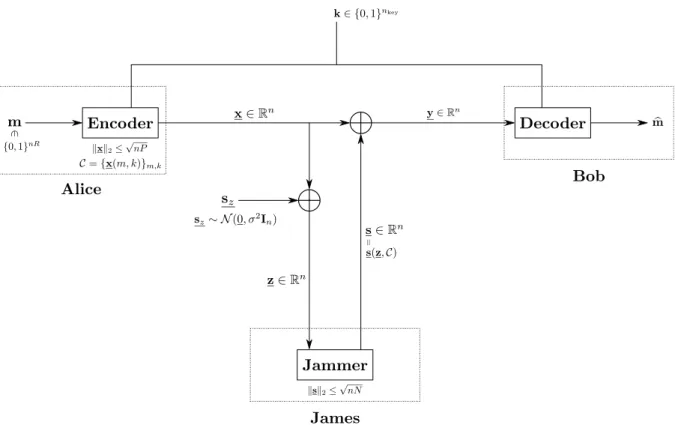
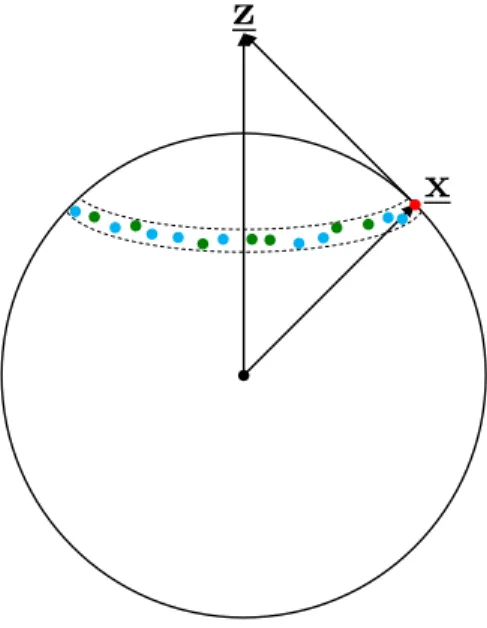
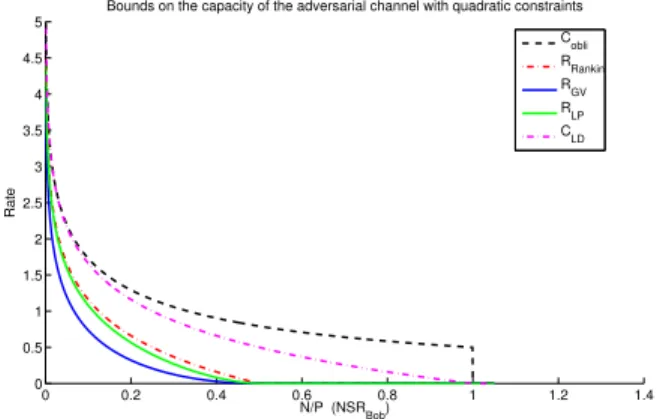

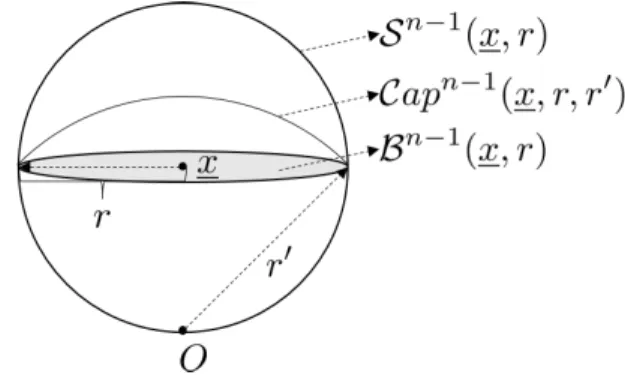
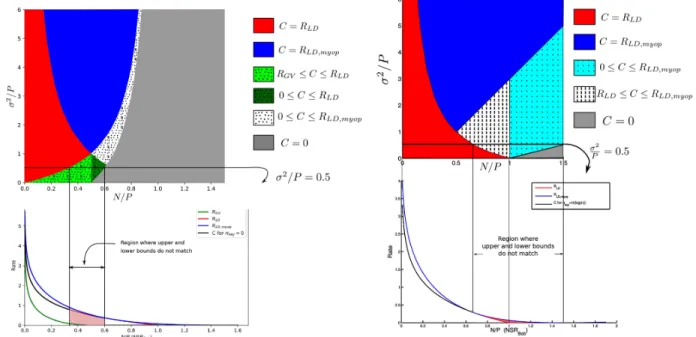
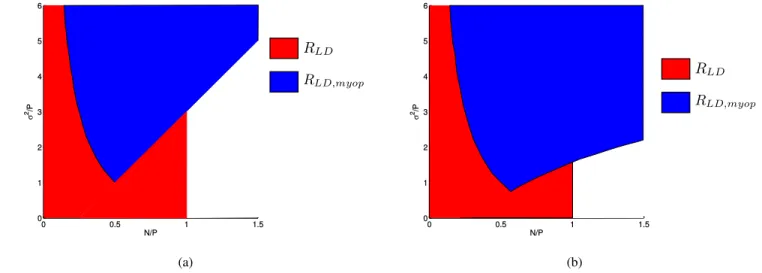
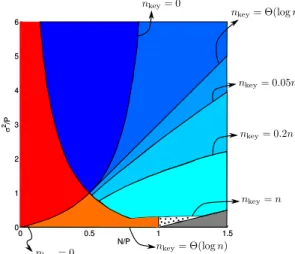
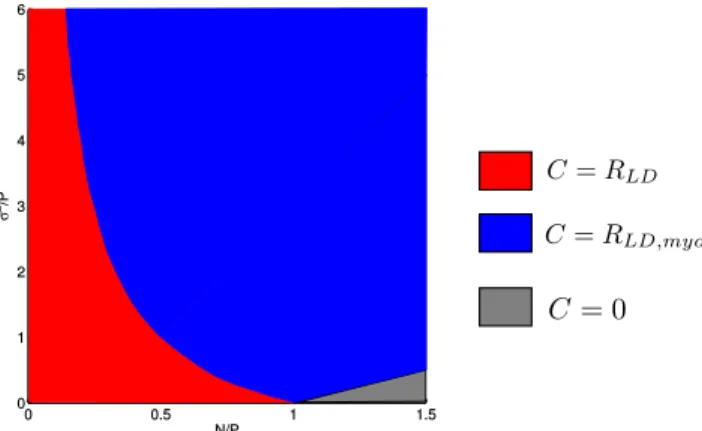
![Fig. 8. Capacity of the myopic adversarial channel for n key = ∞ [1]. The x -axis denotes the NSR from Alice to Bob (with noise from James) and the y -axis denotes NSR from Alice to James (with AWGN added).](https://thumb-ap.123doks.com/thumbv2/azpdfnet/10483416.0/15.918.472.841.423.627/capacity-myopic-adversarial-channel-denotes-alice-james-denotes.webp)